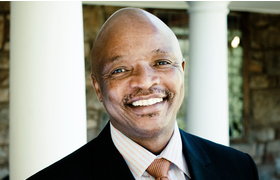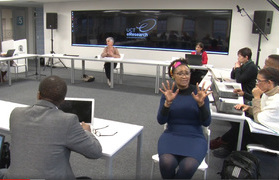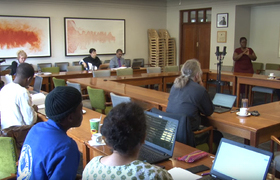UCT skeletons in the cupboard not a mistake, but evidence of a colonial crime against humanity
18 October 2018 | Opinion Wandile Goozen Kasibe. Read time >10 min.The views and opinions expressed here are solely those of the individual authors in their private capacity; they do not represent or reflect the views, opinions or policies of the University of Cape Town or the Communication and Marketing Department.
Although a PhD student at UCT with a thesis focus on “Museums and the Construction” tracing human remains in museums and universities, I was denied access to records and collections. In May 2017, I approached UCT Anatomy Department requesting to be granted access to records and human remains collections that were unethically collected for race ‘science’. I submitted a formal application to access information on 9 July 2017 and received a reply denying my request on 18 August 2017 from the curator of the collection, Dr Victoria Gibbon, as follows “The committee has taken a unanimous decision to deny your ‘Request to Access University of Cape Town’s Anatomy Department Collections and Records’”. The refusal was explained thus: “The main concern for the committee is that your thesis is based on Museum collections…and the remainder of the collections you are using in your study are museums. We are not a museum, and the collection at UCT was not used as such past or present.” In fact, my thesis includes both university and museum collections, and this was ignored. This is a decision that was imposed on my PhD research by an anonymous university committee, denying access to collections and suggesting I should consult secondary sources to answer my questions.
On 22 August 2017, I expressed my disappointment that the committee had taken a decision to deny me access, thus creating an ethos of exclusion that is in direct contravention of the freedom of information at the University. I discussed this matter with my supervisor, Prof Xolela Mangcu who was also disappointed. After I had been denied access to the records and collections, I escalated the matter to the late Prof Bongani Mayosi on 21 May 2018 and whilst awaiting Mayosi’s feedback on the development of my request, I heard the sad news of his passing, may his soul rest in peace.
In the afternoon of 11 October 2018, I watched with excitement as the Vernac News broke the news of the public disclosure of human remains which were unethically acquired by the University of Cape Town’s Anatomy Department in the 1920s. These remains were acquired by UCT during a time of extreme oppression and dehumanization of black Africans in South Africa and globally. In 1921, the Second International Congress of Eugenics was held at the Museums of Natural History in New York, the first almost a decade earlier at the University of London in July 1912. These global eugenics congresses cemented the ongoing institutionalization of race ‘science’ which had a centuries-long history in the colonial Empires. Alan Morris highlights this, “the acquisition of Khoisan skulls can be traced at least as far back as August 1805 when Lichtenstein obtained the cranium of an unknown female Khoi who had been found dead in the veld. Other Khoisan skulls are known to have been part of early nineteenth century private collections, and both Blumenbach in Göttingen and Morton in Philadelphia listed 'Bushman' or 'Hottentot' specimens in their catalogues. By 1850, Khoisan specimens could be found in nearly all of the major European museums. Most of these skulls were donated by or purchased from travelers who had acquired them as curiosities during their visits to southern Africa.” These collections of human remains supported colonial ideology which located indigenous Africans as the ‘missing link’ between apes and modern men; the precursor to modern scientific racism where blacks are associated with monkeys and baboons, thus treated as sub-humans under apartheid.
In the early 1930s, the rise of anti-Semitism and medical experimentation on the ‘undesired’ body of the Jew created the genocide of the Holocaust in Nazi Germany. This also was no accident, as history reveals to us that there was a proliferation of eugenics groups including the Berlin Society of Racial Hygiene; the German Society of Racial Hygiene in Munich; the International Society of Racial Hygiene; the Austrian Society for the Study of the Science of population; the Czech Society for Eugenics; and the Hungarian Society for Racial Hygiene and Population Policy and many other eugenics and racial hygiene movements in North America and Europe.
These eugenics movements in the ‘Global North’ added to processes of racial strata through which the idea of a ‘super race’ and whiteness was constructed as a standard. Horrifyingly, these countries started to look within their own borders to identify populations who would be eradicated for ethnic cleansing and creating of the ‘pure race’.
Whilst the colonial Empire was engaged in racial ‘cleansing’ in the Global North, and in the colonies, universities and museums sought human remains of indigenous Africans: people of Khoi-San and Nguni origin for purposes of race ‘science’ and examination to support eugenics theories. Collections of indigenous people’s human remains were part of a much bigger colonial enterprise in which many museums, universities and scientific institutions across the world were complicit, as observed by Alice L. Conklin “this greater presence of skulls among the peoples of Africa subtly echoed the evolutionary racial hierarchy presented in the Anthropology Gallery, in which Africans were implied to be the least developed of peoples.”
The UCT Anatomy Department human remains collection was started under the stewardship of Robert Black Thomson in 1911, who received donations of skulls from social anthropologists such as Agnes Winifred Hoernle, who acquired human remains from what she “considered to be Hottentot graves” and others who were found exposed at the banks of the Orange River during expeditions in Namaqualand in 1912 and there were also other donators. Thomson studied these skeleton “following the racial typological approach of that time…”, meaning he subscribed to the same colonial violence that fed to notions of black ‘inferiority’ and white ‘supremacy’, with a hierarchy of ‘higher’ and ‘lower’ races whose ‘difference’ would to be highlighted through the study of their anatomy. His successor, Mathew Robertson Drennan, arrived “at the Cape in 1913 to work as a rural general practitioner before succeeding R.B. Thomson as a professor of anatomy at the University of Cape Town in 1919.” Dubow records that Drennan “was dourly contemptuous of the Bushmen he studied, regarded them as anatomical curiosities or living fossils”, asserting that “the majority of the physical characters of the Bushman tend to lie towards the simian end of the human scale, and to this extent the Bushman is undoubtedly a member of one of the lowest of the human races.” To Drennan, “the infantile characteristics of the Bushman should be compared favorably with Neanderthal forms rather than with the ‘higher races’ of modern man.” Drennan here perpetuates the Darwinist notion of the extinction of the first peoples across the world.
It is against this background that I wish to highlight the fact that for over two centuries, African ancestors have endured the degrading practice of racial ‘science’ that masqueraded as academic research. It is quite sad that the Vice Chancellor refers to this acquisition and storage of human remains at this haunted University as a ‘mistake’. But how can it be a mistake when we have historical evidence that reveals to us that universities, museums and other scientific institutions deliberately and consciously acquired unethically collected human remains for racial ‘science’. These people were either stolen from their graves by grave robbers, snatched at battle fields as spoils of war or acquired nefariously from people who were known in life. The justification for amassing the spoils of colonial conquest formed the basis upon which the ‘original sin’ was committed both in universities and museums. The complicated history between universities, museums and indigenous communities is tainted with these unsettling encounters as objects and mortal remains of these indigenous peoples are still in these institutions, and remain classified in a colonial context.
These deeds constitute what could be defined as crimes against humanity. In its history of establishment, UCT has silently been involved in this shameful past of constant trauma and pain. The truth behind the unspoken silences of the racialized dead has finally come out and as part of the university community, I want to propose that the university constitutes a Truth, Repatriation and Reparations Commission with an intention to fully disclose these human rights violations and what Stephen Jay Gould calls “the sins of science” committed under colonialism and apartheid. The Commission must open a public discussion to look into the broader socio-medical questions towards decolonization and de-racialization of anatomical studies and ethics that underpin the practice of medicine. In the University’s attempt to transform and decolonize research methodologies, it must reveal the provenance of the other unnamed individuals who are also languishing in the university’s storage vault of the dead, undisclosed and these include human casts of people such as /Hanaku (Also Anako) whose body was cast in plaster during her visit to Cape Town c.1936. What are the socio-political, cultural, spiritual and ethical implications of unethically acquiring human bodies for race and forensic ‘science’? And what does it really mean to acquire human bodies ethically in the African context? Who has the right to ask questions and access records pertaining to these individuals? Why did it take this long for the University to realize this painful past? This inquiry must be linked to other hidden pasts that still lie silent beneath the University, among others the mass graves that were uncovered on UCT Campus a few years back.
Wandile Goozen Kasibe
PhD Candidate in Sociology, UCT and Chevening Scholar
 This work is licensed under a Creative Commons Attribution-NoDerivatives 4.0 International License.
This work is licensed under a Creative Commons Attribution-NoDerivatives 4.0 International License.
Please view the republishing articles page for more information.









